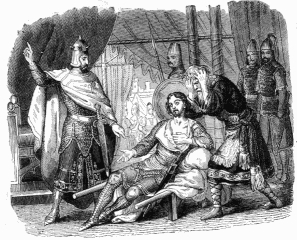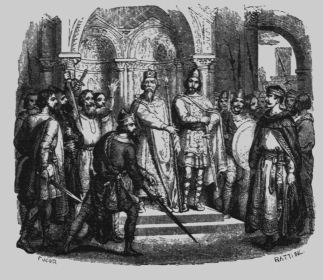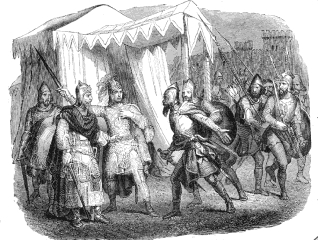Kim Rendfeld's Blog, page 34
January 11, 2013
Happy New Year to ‘The Cross and the Dragon’
[image error]A couple of nice reviews are helping The Cross and the Dragon start off 2013 in a great way.
Lisa J. Yarde, author of historical novels set in the Middle Ages, including The Burning Candle, On Falcon’s Wings, Sultana, and Sultana’s Legacy, is also an active blogger. About The Cross and the Dragon, she writes, “She weaves a powerful tale out of a few strands of history, encapsulated in the epic poem The Song of Roland. Despite scant details mired in legend, there is great emphasis on a vivid portrayal of the medieval period. The author truly brings it to life. Alda and Hruodland’s mutual courage is equally inspiring.” Visit Historical Novel Review blog for Lisa’s full review.
Avid reader and fellow cat lover Jo at Jaffareadstoo says, “The subtle but imposing characters make the story very readable, and even if you know nothing about the middle ages, you will enjoy the experience of stepping back into a time when love and war were intermingled and to be a woman in man’s world was often a frightening and lonely place to be.”
Visit Jaffareadstoo for the full review and my interview with Jo, in which I discuss my second book, The Ashes of Heaven’s Pillar, and talk about the three people from history I would invite to dinner.


January 7, 2013
A Story of Shifting Alliances and Revenge
An author of historical fiction must take the point of view, her characters’, even if she doesn’t completely agree with it. As fond as I am of Alda, the heroine of The Cross and the Dragon, I find her view of eighth-century Lombard King Desiderius oversimplified.
To the teenage Frankish noblewoman, he is an enemy of Rome, and therefore the Church. Her king, Charles, cannot refuse the pope’s pleas for aid, despite concerns about hostilities with the neighboring Saxons.
Yet after doing research about Desiderius for Tinney Sue Heath’s Historical Fiction Research blog, I found his situation was complex, even though he was not a nice guy.
Tinney’s name might be familiar to you. She wrote a posts on Outtakes about Dante’s vision of Charlemagne in the afterlife and Florentines’ claim to the emperor.
The story I’ve written for Historical Fiction Research is a tale of shifting alliances, family honor, and brutal revenge. Visit Tinney’s blog for more.
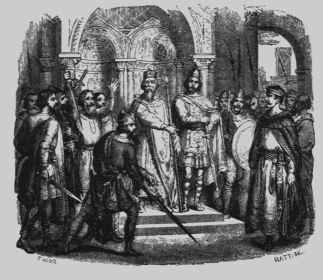
Desiderius holds court in what is believed to be an illustration to Alessandro Manzoni’s Adelchi, a 19th century tragedy.


January 4, 2013
The Poetry of Atoms
It’s the first Friday of the month, which means another installment about the history of atom theory from physics professor and my dad, Dean Zollman. Here, atoms become the subject of Roman poetry. The theory might have gotten more traction if the poet had only stuck to science.—Kim
By Dean Zollman
 Try this experiment at home. Find a small, bright beam of light. Sunlight coming through a small opening or the light from a video projector will do. Looking from the side of the beam, watch the motion of small particles of dust in the beam. You will see that the dust particles seem to bounce around in a somewhat random way. This motion indicates that the dust particles are colliding with invisible atoms in the air.
Try this experiment at home. Find a small, bright beam of light. Sunlight coming through a small opening or the light from a video projector will do. Looking from the side of the beam, watch the motion of small particles of dust in the beam. You will see that the dust particles seem to bounce around in a somewhat random way. This motion indicates that the dust particles are colliding with invisible atoms in the air.
The effect was described by Robert Brown in 1827 and thus is called Brownian motion. The atomic explanation was presented by Albert Einstein in 1905. The discovery and explanation are considered critical events in establishing the existence of atoms.
Rewind the tape about 2,000 years. Lucretius, a Roman who died in about 55 BCE, wrote an epic poem, On the Nature of Things (De rerum natura). In this poem, Lucretius describes the science and philosophy of Epicurus, a Greek who lived about 200 years earlier.
The poem is divided into six books and is about 7,500 lines long. Books 1 and 2 describe Epicurean concept of atoms. Built on the ideas of Democritus, Epicurus added some features particularly about weight, density, and motion. He even connected the motion of atoms to free will. Lucretius was a follower of Epicurus and wrote his epic poem in Latin to convince Romans of the value of this philosophy.
Book 2 contains the following:
There’s a model, you should realize,
A paradigm of this that’s dancing right before your eyes—
For look well when you let the sun peep in a shuttered room
Pouring forth the brilliance of its beams into the gloom,
And you’ll see myriads of motes all moving in many ways
Throughout the void and intermingling in the golden rays
…
Your attention to the motes that drift and tumble in the light:
Such turmoil means that there are secret motions, out of sight,
That lie concealed in matter. For you’ll see the motes careen
Off course, and then bounce back again, by means of blows unseen,
Drifting now in this direction, now that, on every side.
You may be sure this starts with atoms; they are what provide
The base of this unrest. For atoms are moving on their own,
Then small formations of them, nearest them in scale, are thrown
Into agitation by unseen atomic blows,
From Lucretius: The Nature of Things translation by A. E. Stallings, Penguin Classics, 2007.
This short passage could have been a summary of Einstein’s ideas about the origin of Brownian motion. But it was written 2,000 years too early.
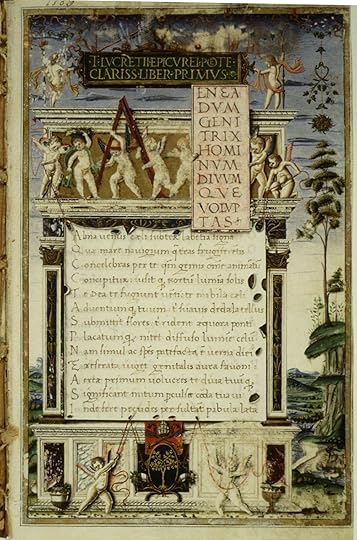
De rerum natura copied by Girolamo di Matteo de Tauris for Pope Sixtus IV, Italy, 1483 (public domain image via Wikimedia Commons).
On the Nature of Things contains descriptions of atoms, their motion, and how they combine. Some by today’s standards are naïve; others like the Brownian motion are rather good.
However Epicureanism was not just science: it was also philosophy. That philosophy included components that did not sit well with many people. For example, the soul died with the body, and gods did not intervene in the affairs of humans. A small issue was that pleasure from sex was considered “unnecessary.”
As a result, 400 years after Lucretius died St. Jerome attempt to discredit him by claiming that he became insane after drinking a love potion and committed suicide. This story was propagated by Tennyson in a poem titled Lucretius. No evidence exists to support St. Jerome’s claim.
Perhaps if Epicurus had held different views of religion and sex, progress on humankind’s understanding of atoms and molecules would have moved much more quickly. Then the nuns at the Abbey of Saint Stephen in The Cross and the Dragon might have had molecular based medicine instead of herbs and prayers to help them nurse Hruodland back to health.
During a recent trip to India, I was reminded of the models of atom developed by Hindu philosophers at the same time as the Greek models were developed. More on that next time.
Previously
What Are Things Made of? Depends on When You Ask.
Ancient Greeks Were the First to Hypothesize Atoms
Dean Zollman is university distinguished professor of physics at Kansas State University where he has been a faculty member for more than 40 years. During his career, he has received three major awards—the National Science Foundation Director’s Award for Distinguished Teacher Scholars (2004), the Carnegie Foundation for the Advancement of Teaching Doctoral University Professor of the Year (1996), and American Association of Physics Teachers’ Robert A. Millikan Medal (1995). His present research concentrates on the teaching and learning of physics and on science teacher preparation.


December 31, 2012
Help Wanted: Where Did These Images of the Lombard King Come From?
Eighth-century writers can be inconsiderate to modern readers. They rarely describe what the people they’re writing about look like nor do they include images.
So the blogger often turns to later illustrations of their subjects. Such is the case with Desiderius, king of Lombardy in northern Italy and the subject of an upcoming guest post on Tinney Sue Heath’s blog, Historical Fiction Research.
Desiderius’s name may be familiar to readers of Outtakes and The Cross and the Dragon. He is King Charles’s ex-father-in-law, and in the early 770s, they fought a war. In an excellent scholarly article, “Pavia and Rome: The Lombard Monarchy and the Papacy in the Eighth Century,” Jan T. Hallenbeck analyzes the complexities that led to the war, which will be shared later.
Right now, I could use some assistance on information about the illustrations I’m considering for the post. Perhaps it is the former journalist in me, but I like to provide readers with information about the images themselves. When were they created? Who is the artist? My usual source for images, Wikimedia Commons, does a pretty good job of this most of the time.
Appearing to be from the 19th century, the images below might have illustrated Alessandro Manzoni’s 1822 tragedy Adelchi, which gets its name from Desiderius’s son Adalgis.
The first (I think) shows Adalgis after Charles’s victory. (In real life, Adalgis escaped to Byzantium during the war and tried to retake his kingdom.) The second shows Desiderius at court and the third, the Lombard camp.
If you can tell me something about any of these images, I would be most grateful.


December 22, 2012
Why December 25 for Jesus’s Birth?
For many years, I thought the Church picked December 25 as Jesus’s birthday to counteract the popular pagan winter festivals. Although that has something to do with the date for the Christian holiday, a peek at the 1908 Catholic Encyclopedia reveals the background is more complex.
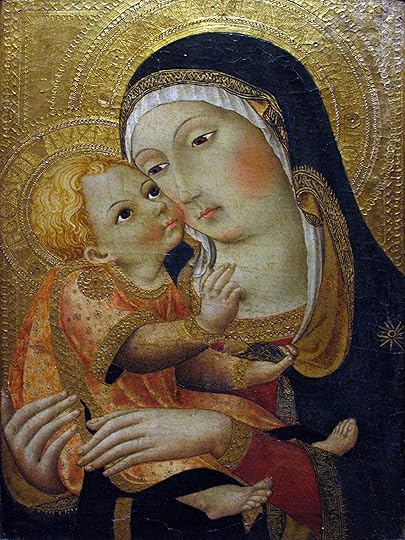
Madonna and Child, a 1460 painting by the master of the Osservanza (public domain image via Wikimedia Commons)
In Christianity’s first couple of centuries, the birth of Christ was not celebrated. St. Irenaeus and Tertullian, who were second- and third-century fathers of the Church, don’t list Jesus’s birth among Christian festivals. Until the third century, the only universal holidays were Easter and Pentecost.
Third century author and teacher Origen thought birthdays were for sinners, and Christian apologist Arnobius (second and third centuries) ridiculed the birthdays of gods.
Yet others who lived at that time were calculating when Jesus was born, and there were multiple answers. In 200, St. Clement of Alexandria said his fellow theologians in Egypt had Jesus’s birthday at May 20. Other conjectures also have Jesus being born in the spring, April 19 or 20 and March 28. Considering that the Scripture describes shepherds watching their flocks by night, a springtime date might be accurate.
Yet Clement also reports that a sect of Gnostics celebrated Epiphany, along with the Nativity, on the familiar January 6 or 10.
By the fourth century, December 25 was becoming recognized as the date for the Nativity. In 386, St. John Chrysostom, a doctor of the Church, was trying to unite the faithful in Antioch in celebrating Christ’s birth on December 25, a date that had been recognized for 10 years.
But why December 25 instead of the solstice, which occurs four days earlier? The so-called astronomical theory ties Jesus’s birth date with a date some believed to be His death. According to this theory, Jesus died on March 25 (a date the writer of the Catholic Encyclopedia article disputes). A divine life must add up perfectly; therefore he was conceived on March 25 and was born nine months later, December 25.
Regardless of the rationale for the date, the holiday brings beauty, joy, and charity when the days are cold and the nights are long here in the north. And that is reason enough to celebrate.


December 20, 2012
Historical Fiction in the Winter Book Blast Event
[image error]Today, The Cross and the Dragon and Of Honest Fame by M.M. Bennetts are representing historical fiction at the Winter Book Blast Event blog hop.
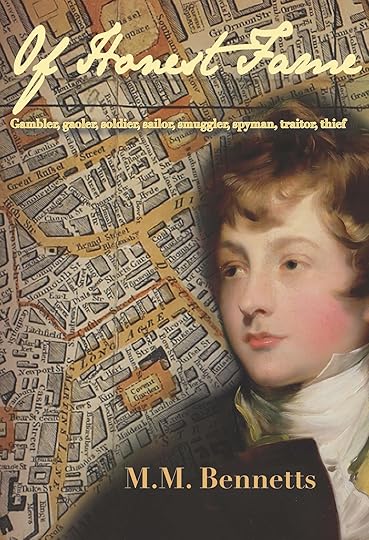 Visit The Edible Bookshelf for more about my debut novel and M.M.’s companion story to her debut, May 1812. The blurb to Of Honest Fame opens with “Gambler, gaoler, soldier, sailor, smuggler, spyman, traitor, thief–A battle of wits against the brutal forces of Napoleon’s tyranny over Europe.” M.M. also writes excellent blog posts detailing the history and devastation of the Napoleonic Wars, something that is not discussed much in the States.
Visit The Edible Bookshelf for more about my debut novel and M.M.’s companion story to her debut, May 1812. The blurb to Of Honest Fame opens with “Gambler, gaoler, soldier, sailor, smuggler, spyman, traitor, thief–A battle of wits against the brutal forces of Napoleon’s tyranny over Europe.” M.M. also writes excellent blog posts detailing the history and devastation of the Napoleonic Wars, something that is not discussed much in the States.
While you’re at The Edible Bookshelf scroll down to enter the giveaway for the grand prize, 18 books, and check out the other participating blogs.
Under way through Dec. 23, the Winter Book Blast features variety of genres such as action adventure, drama, romance, young adult, and fantasy. Visit my Dec. 13 post for a complete schedule, links to previous themes, and a list of authors and their titles. I will add updates to that post as the blog hop progresses.


December 18, 2012
A Mystery: Why Did the King Want to Divorce the Queen?
In The Cross and the Dragon, Frankish Queen Mother Bertrada gives my heroine, Alda, a medal of Saint Andrew, the saint women prayed to for a child. After almost three years of marriage, Alda and Hruodland have not conceived.
Bertrada tells Alda her prayers were answered after she and the late king, Pepin, were childless for three years. What she doesn’t tell Alda is how close she came to never being queen.
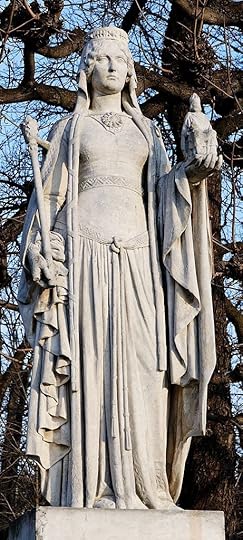
Bertha Broadfoot, 1848, by Eugène Oudiné at Luxembourg Garden, Paris, shows a powerful woman with a scepter in one hand and a man on a throne in the other (copyrighted photo by Marie-Lan Nguyen via Wikimedia Commons).
The historic Bertrada of Laon and Pepin, then mayor of the palace, came from adjoining lands and were married in 744. According to the most recent scholarship, they did not conceive right away.
After two years, Pepin sent an emissary to Pope Zacharias inquiring about illicit marriages. Was he looking for a way out of a marriage that failed to produce an heir? In 747, Pepin gets his answer from Pope Zacharias. Citing two canon, Zacharias says remarriage after divorce is prohibited.
By that time, Bertrada’s prayers might have been answered. Their first child Charles, whom we today call Charlemagne, was born in 748. With a healthy heir, you would think her position is secure, even as Pepin elected king of Francia in 750.
Yet a mystery arises in a 770 letter from Pope Stephen III to Charles and his brother, Carloman, who each inherited portions of their father’s realm and were both kings. The pope is responding to a rumor that one of them will marry the daughter of the Lombard king, his enemy. This is Queen Mother Bertrada’s idea, and Stephen is none too happy. He rails against the Lombards and tells the brothers they can’t set their Frankish wives aside.
“Remember this, most eminent sons,” the pope writes, “that our predecessor of holy memory, the Lord Pope Stephen, adjured your father, of most excellent memory, that he should in no wise presume to cast aside your lady mother, and he, as in truth a most Christian king, obeyed that salutary admonition.”
Stephen II was pope from 752-57. If Stephen did intervene to save the Frankish king’s marriage, it likely would have been in 754, the same time he strengthened Pepin’s kingship through anointing.
Why would Pepin want to divorce the mother of his two healthy sons? It might call their legitimacy as heirs into question and introduce instability into his rule when he was constantly fighting wars.
Although I have seen a reference to Pepin wanting to marry Angla, wife of Theodrad, it doesn’t make sense. If one pope told him he could not remarry after a divorce, a successor would have frowned on it as well, especially if he was breaking up another marriage. And who was Angla?
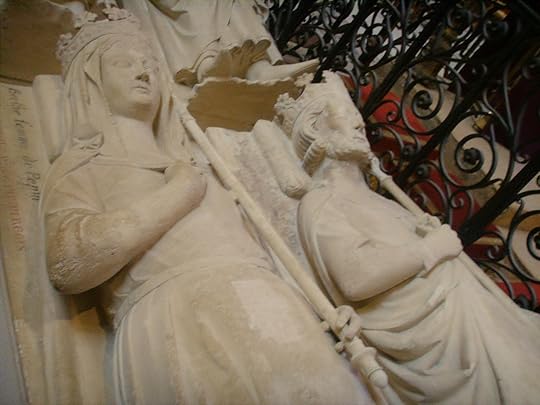
Queen Bertrada and King Pepin are depicted together in 13th century funerary statues at the Basilica of Saint Denis, where they are entombed (photo by Sailko via Wikimedia Commons, used under the terms of the GNU Free Documentation License).
Pepin was not the only one anointed at St. Denis in 754. So were his sons and perhaps even Bertrada herself. Until his death in 768, Pepin was a steadfast husband.
The anointing in 754 is either one heck of a peace offering, or Pepin was not seeking a divorce in the 750s. My theory is rather boring: Pope Stephen III named the wrong predecessor.
Still, if Pepin did try to divorce his queen, I cannot help but marvel at what a formidable personality Bertrada must have been to keep her marriage intact.
Sources
Iona, Tara, and Soissons: The Origin of the Royal Anointing Ritual by Michael J. Enright
Lives of the Popes: The Pontiffs from St. Peter to John Paul II by Richard P. McBrien
Holy matrimony: a treatise on the divine laws of marriage by Oscar Daniel Watkins
Carolingian Chronicles, which includes the Royal Frankish Annals and Nithard’s Histories, translated by Bernard Walter Scholz with Barbara Rogers
You Might Also Like
Traditional Marriage: Eighth Century Frankish Style
Charlemagne’s High Stakes Family Feud (follow the link to Unusual Historicals)


December 16, 2012
“The Cross and the Dragon” visits The Queen’s Quill and Random Bits of Fascination
The Cross and the Dragon made a couple more visits on the blogosphere in recent days—a review at The Queen’s Quill and an interview at Random Bits of Fascination.
Andrea Connell, host of The Queen’s Quill, says: “Simply put, I enjoyed this book. The reasons? Engaging narrative. Steady pace. Strong, living characters. Evocative sense of place and time. A comforting return to the world of chivalry and morality, with defined heroes and villains. Obvious careful attention to research and detail. A touch of the spiritual.”
For three years, Andrea was in the managing editor for the Historical Novel Society’s Indie reviews and has since moved to a position as reviews editor for the print magazine, working with small presses and university presses. She does this one top of family responsibilities and a full-time day job as nonfiction manuscript editor for the Marine Corps historical center.
Andrea’s reviews are thorough and honest. Visit The Queen’s Quill to read her full review of The Cross and the Dragon.
Maria Grace is the host of Random Bits of Fascination. In additions to interviews, she supports other writers by listing interesting posts about history each Thursday and publicizing promotions each Friday.
Grace’s name might be familiar to you. She wrote the excellent post about how laundry was done in the 18th and early 19th centuries. After reading her post, I was never more grateful for my front-loader.
Grace is an author Regency era fiction, including the Given Good Principles series, prequels to Jane Austen’s Pride and Prejudice. She also asks very good questions. Here a sampling:
What did you do with your earliest efforts? Did anyone read them? Did you still have them?
What do you enjoy most in the writing process? What parts of it do you really dislike?
Historical fiction takes a lot of research. What is the most memorable or interesting thing you’ve learned along the way?
Visit Maria Grace’s blog to find out the answers.


December 14, 2012
Interview about “The Cross and the Dragon” at To Read or Not to Read
[image error]Today, The Cross and the Dragon is making an appearance at To Read or Not to Read for an interview with Marcie. Marcie started the blog to share her love of reading, and she asks great questions. Here is a sampling:
How much of your novel is based on actual events?
While researching this novel, did you uncover any unusual/interesting facts?
Describe Alda in three words.
Find out the answers on To Read or Not to Read.
If you have a question about The Cross and the Dragon and you live within driving distance of the New Castle-Henry County Public Library in New Castle, Indiana, you can ask me in person this Saturday during my author chat at 2:30 p.m.


December 13, 2012
Let’s Go to the (Blog) Hop: Winter Book Blast Event
Looking for some winter reading? To help you out, I and other authors are participating in the Winter Book Blast Event blog hop (many thanks to DelSheree of The Edible Book Shelf for organizing this event).
The hop will run from Dec. 15-23, and each day features a different genre. Here is the schedule:
December 15: Action Adventure
December 16: Drama
December 17: Crime
December 18: Romance
December 19: Young Adult
December 20: Historical Fiction
December 21: Mystery/Detective
December 22: Fantasy
December 23: Young Adult Fantasy/Paranormal
Some bloggers are giving away books, and at Edible Bookshelf, DelSheree is offering a grand prize of 18 books. To enter, click on the Rafflecopter giveaway link.
Here are the participating blogs, with those who are giving away books.
The Edible Bookshelf (giveaway)
K.W. McCabe
Winter Blog Hop (giveaway)
Into the Rabbit Hole
Turning the Pages (INT giveaway)
EOLYN Winter Book Blast and Giveaway
The Grateful Undead (Giveaway)
Flying Horse Books
Books, Books, Books
Judy Goodwin: Heart of the Witch
Janet Taylor-Perry Author Page
Are You Ready for Coming Flu @ jl greger blo
The Authors Blog @ James R. Callan (giveaway)
Winter Book Blast/Ann Everett (Giveaway
Let’s Go to the (Blog) Hop: Winter Book Blast
Linda Benson
InLinkz.com




